Donald MacLean's Blog 5
PLACES
(1925/1934)
She ... Mary ... is 20, newly
graduated from Physical Training college (so - for this is 1925 - she's a "Gym
Teacher") and she is on her way to babysit for friends in North London.
He ... Kenneth ... is 28, and is
on his way to deliver a Cairn puppy to these same friends.
They are introduced to each
other and the friends depart for the evening.
When they return the puppy is
content with its new home, Kenneth is still there ... and he and Mary are
engaged!
In the summer they are
honeymooning in the Lake District in their bull-nosed Morris with three Cairns
in the dickey-seat.
Since resigning his army commission as an Engineer Officer, Kenneth has become one of Britain's first 'company doctors', turning-round troubled businesses for the Official Receiver.
The following year their
first offspring arrives. A boy. Me.
If this suggests that my
parents were equally matched in dynamic, strong-minded, cussedness, I won't
dissent. And if you suspect that consequently their long and successful
partnership was many things but never dull you would, again, be right.
My third blog recalled people
and events linked by the thread of THINGS - my 35 cars. In due course
I'll return to that thread (with Computers and Cameras). This, the 5th
chapter of my story, relates the people and events recalled by my parents'
nine successive homes. From 'THINGS' to 'PLACES'.
- - - - - -
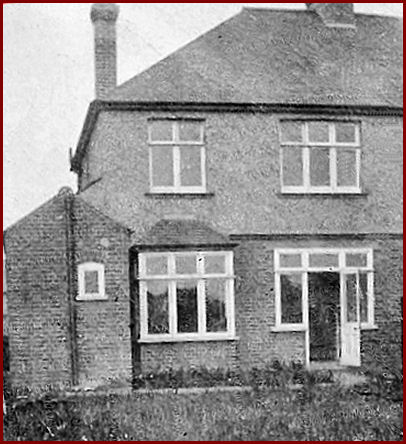 |
|
|
Luton. About an hour's
drive (in a bull-nosed Morris) on the main road North from London.
Biscot Road, Luton. In 1926 the home of "Commercial Cars Ltd",
trade-name "Commer Cars", founded in 1905 to make load-carrying versions of
the new-fangled motor car.
With 'Commer' vans being
shipped world-wide the company became, with the 1914 war, the main
supplier of armoured cars. Post war, competition had increased and by
1923 Commer was in receivership - bankrupt.
The long established
accountancy firm Tansley Witt were given the task of administering Commer, and
as manager they hired a recently retired military engineer who had spent much
of the war supervising the supply of armoured cars to the army in Europe and
Africa (including the conversion of most of the aristocracy's Rolls Royces).
Which is why, in 1926, this
new member of the ancient Clan Maclean made his debut not in the Hebrides but
in Luton, Bedfordshire (whose town council now operates in 28 official
languages - from Gujarati to Urdu - with narry a whisper of 'the Gaelic').
And it was at Commer that my
father first showed a characteristic that will recur through this tale - being
rarely satisfied with the status quo.
If you were to sidetrack now
and do a Google ... please don't ... you would find that vans - Ford
"Transits" for example - come in two forms: "Box" and "Luton". Here's
why:
In 1926 Luton's main industry was the making of hats. (I'm told that the town's football team is still called "The Hatters".) Hats weigh very little. High volume-to-weight ratio. A van choc-full of hats would be physically capable of carrying more if there were room. My father asked the designers to use the area above the cab to extend the cargo space. The "Luton" van was born. Shortly after me.
Late in the 1914/18 War my
father had met a young naval officer, William, also an engineer, and evidently
with a similar innovative mindset. William had been demobbed early in
order to put into practice his revolutionary notion that the engines of
aeroplanes could be repaired instead of scrapped. With his brother
Reginald, he subsequently developed their father's cycle-shop in a Kent
village into Europe's biggest chain of car-dealers.
William had undoubtedly
discussed with my father his plans to embrace also the manufacture of cars and
by 1926 the brothers had acquired the 'Humber' and 'Hillman' car plants and
William was introducing modern mass-production methods to help them through
the difficult twenties.
It was in their new offices
and showrooms - Devonshire House in London's West End - that my father
persuaded William that he should add the making of commercial vehicles to his
growing empire - by buying the 'Commer Cars' company.
By 1939 and WWII the company had added to 'Humber', 'Hillman' and 'Commer', the 'Talbot', 'Karrier' and 'Sunbeam' brands and the Group, headed by William, now Lord Rootes, was a world leader.
- - - - - -
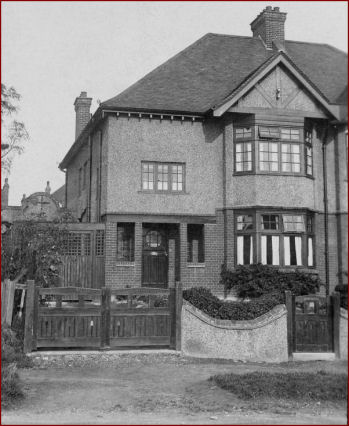 |
|
|
The successful resolution of
Commer's problems must have attracted attention because Kenneth McLean was
immediately asked to take-on another company - they had opened a factory near
Commer in Luton and their offices were at Piccadilly Circus in London.
Which brought the McLean family to their home nr 2.
It was here, in 1928, in
Finchley, London N12, that the trio became a quartet with the birth of my
brother Nigel.
Our neighbours, the elderly
Mrs Henderson and her daughter Flo, became lifelong family friends.
'Aunty Flo' was still in the management of the Chappell Music Company in Bond
Street when I was responsible for the BBC's popular music output in an
office across the road from them. And, later still, I can picture her
visiting my mother in (final) house Nr 9 - two dignified, silver-haired old
ladies, deep in argument, still with a mischievous twinkle in their eyes.
Aged 2 the nearest I got to
pronouncing Mrs Henderson's name was "Senders" and I remember her chiefly for
her present to me on my second birthday - a pedigree Blue Persian kitten.
I called him Sandy and he slept at the foot of my bed through all the years
until, in my teens, I departed for war service.
One Christmas, a few years
after we'd moved to York (home Nr 5) my brother and I, aged 5 and 7, were put on
a train to London to visit Senders (in those days it was safe - though the
train's guard was charged with our wellbeing, and the Stationmaster on our
arrival was on parade, top-hatted, to receive us).
Aunty Flo had arranged a special outing for us - dinner at Fortnum's in
Piccadilly (one of my favourite restaurants to this day) then the pantomime at
Drury Lane. Thanks to Flo's business connections we were seated in the
Royal Box - from which Nigel regurgitated much of his dinner while looking
down at the hapless commoners in the stalls.
Back in 1922 a pair of
engineering students, Baltzar von Platen and Carl Munters, at the Royal
Institute of Technology in Stockholm, had created a revolutionary new machine
that produced cold. The world's first refrigerator.
The Swedes had formed a
production company, 'AB Arctic', to manufacture them. It had been
taken-over by a larger company who were already marketing one new gadget -
vacuum cleaners - and who were now planning to launch the "D-fridge". Given the subsequent records of both this company and my father
I think we can assume that his management of the launch of the world's first
fridge was remarkably effective.
I should mention that I later changed the spelling of my name to MacLean. And that the new appliance company also changed its spelling ... from Elektrolux to Electrolux.
- - - - - -
With Electrolux sales
burgeoning, Kenneth notes that "1 office/1 typist had grown into a
staff of 600, including 3 Sales Managers and an Accountant", and
"at
this point the Chairman agreed an urgent request from Tansley Witt for me to
go to Ransomes in Newark-on-Trent where, on behalf of their bankers, I joined
their Board as Commercial Director."
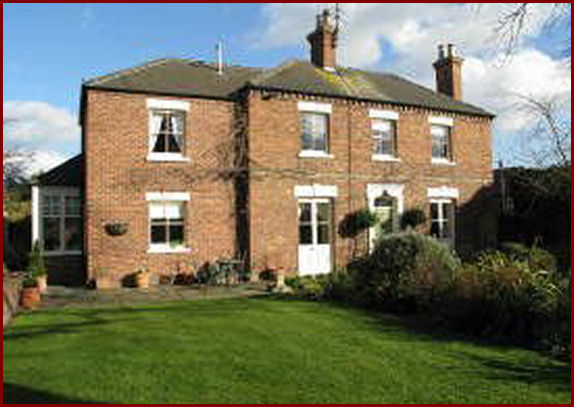 |
|
(Picture from website of 2009 Estate Agent) |
So ... in 1929 the McLean family moved to Home Nr 3 - a one-year rental in Southwell, Nottinghamshire.
My brother and I can recall only a few things about this phase of our lives:
1. Most folk pronounce it "Suthell" (apparently as correct as "South-well").
2. Our mother used to push Nigel's pram round the nearby grounds of Southwell Minster (which Nigel invariably called "the mincer").
3. The extensive garden (now a block of flats) had a tree which
was said to be the world's first Bramley apple tree. (Bramleys were
first cultivated in the town, so perhaps this was true).
[In 2008 I wrote to "Owner or Occupant", Alma House, Southwell (having failed
to find the road) and asked if they would be kind enough to tell me the
address
so that I might obtain a photograph. The letter was returned
undelivered. The editor of the local paper (called The Bramley) then
kindly published my request and
I received a charming letter from a lady whose home it once was -
giving me the full address and saying that she and her late husband had
changed the house's name fifty years ago. This was followed by an email
from another lady saying the house was on the market - and giving me the
agent's website address from which we could see many views of interior and
exterior.]
The Newark company not only returned to solvency but flourished, became Ransome & Marles, world-leading maker of bearings and, after several further metamorphoses, flourishes today.
- - - - -
"In 1930," wrote my father, "I sought a more solid base for my business career and joined a large number of applicants to be Manager of a Sales Research project at the Rowntree chocolate company, and was selected. I moved to York and progress was rapid. I became controller of all Rowntree sales operations in UK and worldwide, and when the American Beech Nut Corporation signed a joint venture with us I became also Managing Director of Beech Nut (England) Ltd."
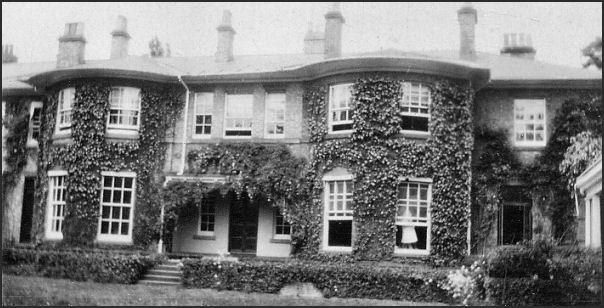 |
|
|
While my parents house-searched they rented the ground-floor flat of Clifton Lodge, on the outskirts of York. From there it was a brief walk to the Prep School in Bootham where I met my oldest (rather, longest-time) friend Dr Kenneth Everard. As 4-yr-olds we sat together, terrified, waiting to be interviewed by the Misses Singleton and Meaby. (And decades later were surprised to find ourselves fellow nominees for peerages in the government's ridiculous "Peoples' Peerages" exercise.)
If you were to research the history of confectionery now you would find the following (I'm sure Rowntree won't mind my quoting from their website): "The first boxes of Black Magic were unwrapped in 1933 after an extensive consumer survey ... one of the very first examples of mass market research ... 3,000 people taste–testing."
This was a remarkably successful exercise given that the products which it launched over the next few years - Black Magic, Kit Kat, Aero, Dairybox, Blue Riband, Quality Street, Rolo, Smarties - remain household names more than 70 years later. My brother and I were happy to be the guinea-pigs on whom the taste-tests were first tried-out!
(My good friend Kenneth Everard reminds me of the time my father gave us money for sweets and was perhaps a little miffed when we both purchased Mars Bars!)
(If you ever search for a potent example of mass-production try this - in 1993 Rowntree opened a new factory where the machines produce one ton of chocolate every 15 minutes.)
The outbuildings at Clifton Lodge were home to Mr Marshall's riding school - our nursery window looked onto the stable yard. My parents and brother and sister were always happier on horseback than I was (Dad had his jodhpurs, boots and riding-jacket tailored by Hackett of Savile Row).
In my preamble I whispered to you that I made an excursion into the shrubbery here with a 6-yr-old seductress. (Oh yes - I do recall the details - and no, I couldn't possibly share them - even with you). I do wonder if somewhere a genteel old lady may occasionally pause her knitting and smile to herself?
My other memories of Clifton are of seeing a Baird TV receiver in the Morgan's flat upstairs, and of my mother (every bit as entrepreneurial as my father) attaching to my pedal-car rudimentary wings and a propeller ... which perhaps sowed the seed which led me later to a Private Pilot's Licence?
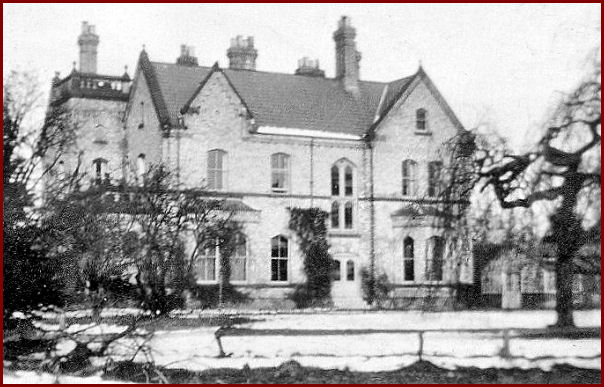 |
|
|
One Sunday in 1930 we were driven 4 miles North of York to the village of Skelton to see the house which our parents had bought - and which was to be our home (Nr 5) for the next 4 years. Even by the standards of traditional manor houses it was impressive.
Its owner, like my Father a retired army man, had clearly fallen on hard times - I still picture him leading us into a spacious
room in which a tree-trunk was propped on a biscuit-tin while its other end burned in the huge fireplace.
Skelton was where sister Deirdre arrived - so now we were a quintet. As a baby I'd had a devoted nanny who had been a maid in Grandpa Heron's house, but with Deirdre a new element entered the family hierarchy - a nurse in traditional uniform who required her own quarters, next to the nursery. Because these upmarket ladies came with assumptions which tended to conflict with my father's view of where authority in the household properly resided there were, as I recall, a series of nurses! (A circumstance inevitably repeated later with sister Fiona.)
Skelton is where many of my poignant memories originate.
Much of the house remained unused. Years after we had moved-in, I wandered into a corridor whose empty rooms had been used by someone to store hundreds of apples from the orchard ... by now very very mature!
There was a 100-acre paddock with a little lake and an island. We were forbidden to use the elderly boat, but during one cold winter (when that photo was taken) the lake froze and my parents sailed sedately around it on skates.
A walled-garden where peaches and vegetables grew - in one corner a potting-shed where the Gardener, Hayden, ate his sandwiches and told us tales of his four sons who were the Yorkshire Dales' entire squad of Automobile Association "Scouts". On our Sunday outings we received respectful salutes from them, in their breeches and polished knee-boots, riding motorcycles with yellow sidecars full of tools.
Our mother had a sewing-room
at the Grange which she loved - it was in a tower (on the left of the photo) - so I thought of her as a princess. (I recognised that she was entirely capable of knotting some sheets together to elope with a handsome prince, and prayed that she wouldn't.)
In the mysterious basement was a hot-air engine whose fire was lit at 6am every Thursday so that by lunchtime it was ready, grudgingly, to pump water from a well to the cistern for the house.
In the stable yard was another well with an old 10 foot high hand-pump. Our mother kept a tumbler there, urging us to drink this pure water when thirsty.
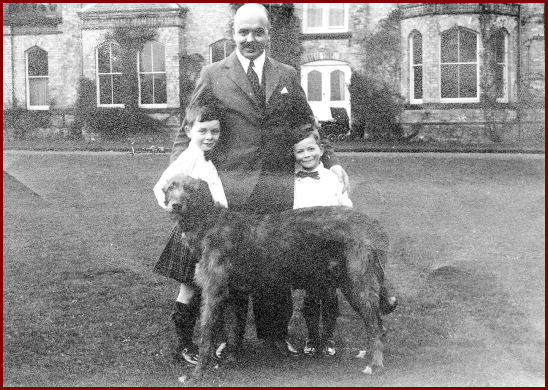 |
|
|
There were two entrances to the grounds. The one we used had been the service entrance - its driveway was shorter, started in Skelton village and terminated in the stable-yard. The other driveway came from a lodge (then unoccupied) on the main road and wound its neglected, weedy way through the paddock to somewhere to the left of the photo. It features in McLean family folklore - I'll abbreviate:
Father was the UK head of an Anglo-American company (see above). Its US President was a Mr Katzman who, with his wife, came to visit us ... on the Sunday before the one my parents had (they thought) invited them.
We returned from a picnic on the Pickering Moors to find a Cadillac sitting in the paddock, the wrong side of a ditch (called a 'haha'). Its rear had been significantly remodelled by the bull into whose territory it had intruded - sending the occupants clambering over the fence.
My parents, hiding their astonishment that anyone had succeeded in opening the ornate but rusted lodge gates, eventually discovered their guests seated forlornly on the steps of a doorway long unused. It had once been the main entrance - where the carriage of the Lord of the Manor would have deposited him. Now, however, my parents considered it could be seen as appropriate only to strangers whose image of England clearly included rusty gates and overgrown driveways!
Staff were roused from their day-off and dinner hastily organised. (The butler Hepworth and his wife, who was Cook, plus a table-maid.)
Dinner became a disaster in keeping with their arrival. A major storm arrived and a lightning strike lifted the cutlery into the air, smashing some of the heirloom china as it fell. Shortly after came the sounds of raised voices offstage, causing mother to excuse herself and exit - to find the Hepworth menage engaged in civil war - at the expense of the crockery that had previously remained virgo intacta in the kitchen!
In those days everyone - men & women - wore hats. Hepworth had properly deposited those of the visitors on pegs in the cloakroom. Now, in keeping with a script which any sitcom producer would have long ago rejected, everyone emerged from the dining-room to find the remnants of expensive American headgear, lifted from the pegs by our two Irish Wolfhounds and comprehensively shredded in the hall.
It is as much a testament to the Katzman's sense of humour as to my parents' social skills that Transatlantic accord remained strong for many years ... while Britons in their millions chewed their way through an ever-increasing annual tonnage of Beech Nut gum.
I think we can assume, don't you, that many an American and English dinner party was subsequently regaled with alternate versions of that summer Sunday?
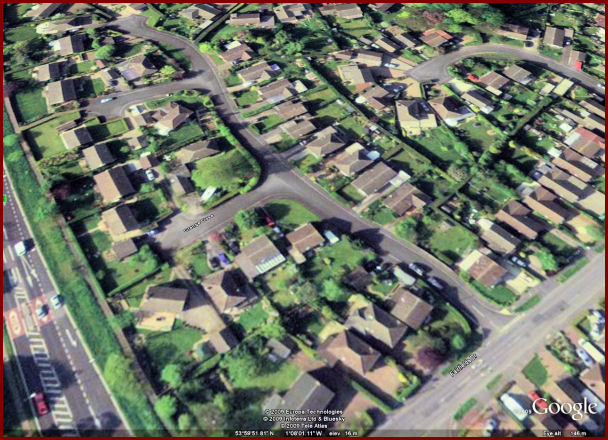 |
|
|
25 years later my brother, sister and I were in York and went to Skelton. The village looked familiar but nothing else. Where the Grange had been (and the lodges and the paddock and the walled garden and the stables) was a large estate of nice, very new, houses.
Having failed to find anything remotely familiar the others went back to the car. Some instinct led me to explore a little - trying to visualize where the driveways would have been, the house, the stables. Fishing out my camera I composed a shot of a row of pristine houses ... and there in the viewfinder, as a 'feature' at the side of a front garden and wreathed in Clematis, stood an old 10 foot high hand-pump.
I hope you will allow me to share with you, in a future blog, the people and events recalled by subsequent homes.
D.H.M.
- - - - -
- - - - - -
Back to 'Contents' table
On to Blog 6
- - - - - -